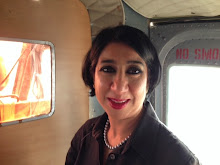The many colours of red
M.J. Akbar
Red is not a single colour. By the second half of the Sixties most of the world Latin America, Africa, Asia, most of Europe was awash in its many hues, and Vietnam took its counter-intuitive edge to the campuses and television screens of America. By the late Sixties, and through the early Seventies, the Naxalite offensive had turned parts of India scarlet. The epicentre was Bengal, but the seepage was powerful enough to affect Delhi. Mrs Indira Gandhi, the most perceptive politician of the last half century, recognised its implications amidst the comfort zones into which a slothful Congress leadership had retreated. She broke the party and reinvented herself as a pink ruby in a clutter of paste diamonds.
Mrs Gandhi was astute enough to launch a major offensive against poverty, but did not have the economy to sustain her political will. Nor did she have the conviction in shared governance to build alliances within Parliament, and with industry, labour, peasantry, academia and media that could become the vanguard of change. India is too heavy a weight. It moves only when we all pull together.
That familiar adage of the freedom movement when Bengal sneezes, India gets a cold worked for the last time during the red upheaval of the Sixties. The sun rose from the east, but that sharp red streak of dawn faded quickly in the harsh sunlight of the rest of India. Bengal rejected scarlet, and dyed itself in the pale red of democratic communism, introducing a doctrine that challenged other applications of the phrase. Where the Soviet-East European model, for instance, gave primacy to communism over democracy by subverting the latter into a one-party dictatorship, Bengal became a one-party state in a cooperative electoral process that legitimised the party through election victories that might arouse scepticism, but whose credibility could not be challenged. The fulcrum of Communist rule in Bengal was social stability, which Congress had destroyed in the Sixties by cynical manipulation. The peace of the last three decades has veiled the fact that Bengal is a partition province, with a history of Hindu-Muslim antagonism that has deeper roots than Punjab. The Muslim League was born in Bengal; and Punjabi literature has nothing compared to the anti-Muslim froth that layered so much of the best Bengali writing in the 19th and early 20th centuries.
Why is the colour of Bengal swirling back towards the tricolour of India? There are many reasons, of course, including the rather obvious failure of the Left to embed itself into the consciousness of contemporary youth in the manner that it once dominated the minds of Bengali youth in the Seventies and Eighties. The young comrades who once drove a wedge into the sky kept the dream alive in their children, but have now lost their grandchildren, the teenagers who are leading the celebrations after every Mamata Banerjee victory. But there is a second, equally important, albeit unrecognised, reason for the electoral debacle.
We are used to dividing Bengal along Hindu-majority West and a Muslim-majority East, with the border as the only definition. But there is a new West and East in our Bengal. Official statistics say that the Muslim population of West Bengal is 28%; it might rise to 30% after the current census. But this demographic is not evenly distributed. Muslims are concentrated in the eastern districts of West Bengal, parallel to Bangladesh, forming about 40% of the voting population in the thickly populated regions south, east and north of Calcutta. Any map of the results will show that the core reason for Mamata Banerjees success lies in the shift of the Muslim vote from the Left towards her persona.
One uses this term carefully, since she is at the moment a personality who has inspired a revolt, but not been able to institutionalise her advance into a political structure. It is interesting that Muslim enthusiasm for Mamata has not transferred to the Congress. The Left has made gains where it contested the Congress, and its overall vote has increased by 4% compared to last years general elections. The Congress was routed in Pranab Mukherjees constituency, which has a Muslim majority.
If Mamata repeats this performance in the Assembly elections, one-party rule will be replaced by one-woman rule. The Left, technically, is a coalition, but in truth, Bengal has been ruled by the CPI(M). Having ensured social peace for three decades, the CPI(M) took the Muslim vote for granted, indifferent to the reality that the grandchild was not ready to accept what father had.
Could anything change what is widely seen as inevitable? The Left has begun to implement a job reservations policy for minorities; we do not know if this is too little, too late. Change is an exciting thought for a generation that has not experienced violence, so the young may dismiss this as a cynical last throw of the dice by a defeated gambler. Moreover, Mamata has empowered Muslims by making more of them candidates, but she will be vulnerable where she gives seats to the Congress.
The red of Bengal has already been diluted by time. The tint of the future will be determined in 2011, and the easel is with the Muslim voter. Both sides know that.
The columnist is editor of The Sunday Guardian, published from Delhi, and India on Sunday, published from London
Friday 11 June 2010
Subscribe to:
Post Comments (Atom)


No comments:
Post a Comment